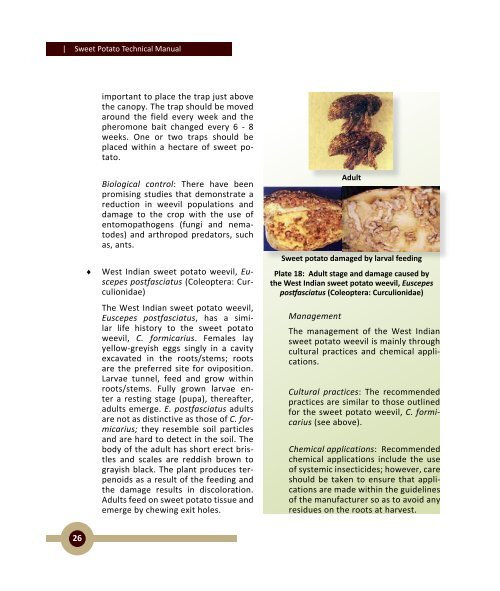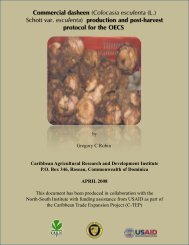Sweet Potato Technical Manual - Caribbean Agricultural Research ...
Sweet Potato Technical Manual - Caribbean Agricultural Research ...
Sweet Potato Technical Manual - Caribbean Agricultural Research ...
Create successful ePaper yourself
Turn your PDF publications into a flip-book with our unique Google optimized e-Paper software.
| <strong>Sweet</strong> <strong>Potato</strong> <strong>Technical</strong> <strong>Manual</strong><br />
26<br />
important to place the trap just above<br />
the canopy. The trap should be moved<br />
around the field every week and the<br />
pheromone bait changed every 6 - 8<br />
weeks. One or two traps should be<br />
placed within a hectare of sweet potato.<br />
Biological control: There have been<br />
promising studies that demonstrate a<br />
reduction in weevil populations and<br />
damage to the crop with the use of<br />
entomopathogens (fungi and nematodes)<br />
and arthropod predators, such<br />
as, ants.<br />
♦ West Indian sweet potato weevil, Euscepes<br />
postfasciatus (Coleoptera: Curculionidae)<br />
The West Indian sweet potato weevil,<br />
Euscepes postfasciatus, has a similar<br />
life history to the sweet potato<br />
weevil, C. formicarius. Females lay<br />
yellow-greyish eggs singly in a cavity<br />
excavated in the roots/stems; roots<br />
are the preferred site for oviposition.<br />
Larvae tunnel, feed and grow within<br />
roots/stems. Fully grown larvae enter<br />
a resting stage (pupa), thereafter,<br />
adults emerge. E. postfasciatus adults<br />
are not as distinctive as those of C. formicarius;<br />
they resemble soil particles<br />
and are hard to detect in the soil. The<br />
body of the adult has short erect bristles<br />
and scales are reddish brown to<br />
grayish black. The plant produces terpenoids<br />
as a result of the feeding and<br />
the damage results in discoloration.<br />
Adults feed on sweet potato tissue and<br />
emerge by chewing exit holes.<br />
Adult<br />
<strong>Sweet</strong> potato damaged by larval feeding<br />
Plate 18: Adult stage and damage caused by<br />
the West Indian sweet potato weevil, Euscepes<br />
postfasciatus (Coleoptera: Curculionidae)<br />
Management<br />
The management of the West Indian<br />
sweet potato weevil is mainly through<br />
cultural practices and chemical applications.<br />
Cultural practices: The recommended<br />
practices are similar to those outlined<br />
for the sweet potato weevil, C. formicarius<br />
(see above).<br />
Chemical applications: Recommended<br />
chemical applications include the use<br />
of systemic insecticides; however, care<br />
should be taken to ensure that applications<br />
are made within the guidelines<br />
of the manufacturer so as to avoid any<br />
residues on the roots at harvest.




